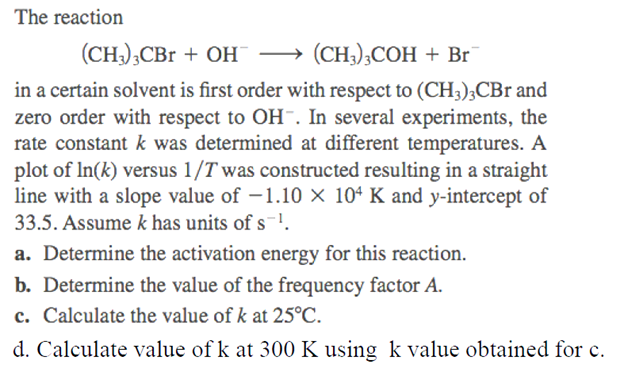The reaction (CH3)3CBr + OH(CH3)3COH + Br in a certain solvent is first order with respect to (CH3)3CBr and zero order with respect to OH. In several experiments, the rate constant k was determined at different temperatures. A plot of ln(k) versus 1/T was constructed resulting in a straight line with a slope value of -1.10 x 104 K and y-intercept of 33.5. Assume k has units of s¹. a. Determine the activation energy for this reaction. b. Determine the value of the frequency factor A. c. Calculate the value of k at 25°C.
The reaction (CH3)3CBr + OH(CH3)3COH + Br in a certain solvent is first order with respect to (CH3)3CBr and zero order with respect to OH. In several experiments, the rate constant k was determined at different temperatures. A plot of ln(k) versus 1/T was constructed resulting in a straight line with a slope value of -1.10 x 104 K and y-intercept of 33.5. Assume k has units of s¹. a. Determine the activation energy for this reaction. b. Determine the value of the frequency factor A. c. Calculate the value of k at 25°C.
Chemistry & Chemical Reactivity
9th Edition
ISBN:9781133949640
Author:John C. Kotz, Paul M. Treichel, John Townsend, David Treichel
Publisher:John C. Kotz, Paul M. Treichel, John Townsend, David Treichel
Chapter14: Chemical Kinetics: The Rates Of Chemical Reactions
Section: Chapter Questions
Problem 66GQ
Related questions
Question
number 5

Transcribed Image Text:The reaction
(CH3)3CBr + OH →→→→→ (CH3)3COH + Br
in a certain solvent is first order with respect to (CH3)3CBr and
zero order with respect to OH-. In several experiments, the
rate constant k was determined at different temperatures. A
plot of In(k) versus 1/T was constructed resulting in a straight
line with a slope value of -1.10 × 104 K and y-intercept of
33.5. Assume k has units of s¹.
a. Determine the activation energy for this reaction.
b. Determine the value of the frequency factor A.
c. Calculate the value of k at 25°C.
d. Calculate value of k at 300 K using k value obtained for c.
Expert Solution
This question has been solved!
Explore an expertly crafted, step-by-step solution for a thorough understanding of key concepts.
This is a popular solution!
Trending now
This is a popular solution!
Step by step
Solved in 2 steps with 1 images

Knowledge Booster
Learn more about
Need a deep-dive on the concept behind this application? Look no further. Learn more about this topic, chemistry and related others by exploring similar questions and additional content below.Recommended textbooks for you

Chemistry & Chemical Reactivity
Chemistry
ISBN:
9781133949640
Author:
John C. Kotz, Paul M. Treichel, John Townsend, David Treichel
Publisher:
Cengage Learning

Chemistry & Chemical Reactivity
Chemistry
ISBN:
9781337399074
Author:
John C. Kotz, Paul M. Treichel, John Townsend, David Treichel
Publisher:
Cengage Learning

Chemistry
Chemistry
ISBN:
9781305957404
Author:
Steven S. Zumdahl, Susan A. Zumdahl, Donald J. DeCoste
Publisher:
Cengage Learning

Chemistry & Chemical Reactivity
Chemistry
ISBN:
9781133949640
Author:
John C. Kotz, Paul M. Treichel, John Townsend, David Treichel
Publisher:
Cengage Learning

Chemistry & Chemical Reactivity
Chemistry
ISBN:
9781337399074
Author:
John C. Kotz, Paul M. Treichel, John Townsend, David Treichel
Publisher:
Cengage Learning

Chemistry
Chemistry
ISBN:
9781305957404
Author:
Steven S. Zumdahl, Susan A. Zumdahl, Donald J. DeCoste
Publisher:
Cengage Learning

Chemistry: An Atoms First Approach
Chemistry
ISBN:
9781305079243
Author:
Steven S. Zumdahl, Susan A. Zumdahl
Publisher:
Cengage Learning


Chemistry: Principles and Practice
Chemistry
ISBN:
9780534420123
Author:
Daniel L. Reger, Scott R. Goode, David W. Ball, Edward Mercer
Publisher:
Cengage Learning